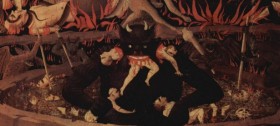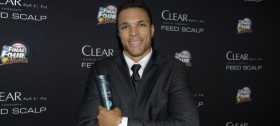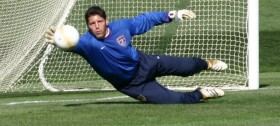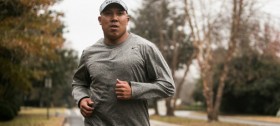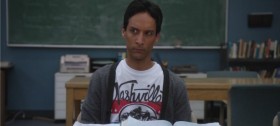Ines Sainz Interview
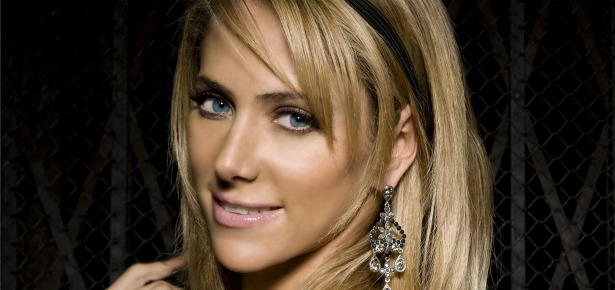
It’s funny how sports lets us talk about cultural themes that we don’t normally discuss in everyday conversation. Let’s take gender equality for example. It’s not really something you talk about on the regular, but when the women’s basketball team at UConn tries to break the all-time NCAA basketball winning streak, the issue becomes a source for water cooler conversation all week. Sports allows us to talk about bigger issues in a totally detached, relaxed and conversational way. Under the umbrella of athletic competition, no topic is off limits. Everything – culture, identity, values, etc. – can be folded in.
That’s why the Ines Sainz/Jets story took on such a life of its own. Sexism and exploitation are interesting topics, but they become much more discussable when wrapped in the easy-going blanket of sports talk.
I’m sure you’ve heard about what happened when TV Azteca reporter Ines Sainz visited a Jets practice back in September. Stories came out that this stunning reporter was subjected to all kinds of disrespectful behavior by the Jets players (and other members of the organization). Balls were thrown her way on the practice field so that players could try to bump into her. There was some lewd behavior reported in the locker room when Sainz was trying to interview QB Mark Sanchez.
Sainz was embarrassed and tweeted about it. Fellow reporters were offended and jumped to her defense. The Association for Women in Sports Media stepped in and filed a complaint with the Jets and the NFL. The story blew up, and Sainz even appeared on Good Morning America to talk about it.
After the story reached critical mass, two opinion camps formed. One camp saw Sainz as a victim of sexual harassment, in the workplace no less. Here’s a woman with an established career as a professional sports journalist who was mistreated by a bunch of chauvinistic, sophomoric football players. Her rights needed to be defended, and the culture of pro football players, with respect to their treatment of women reporters, needed to be changed dramatically.
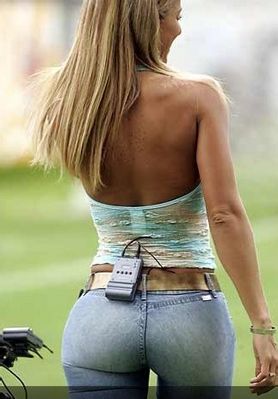 The other camp saw Sainz as an opportunist. A sexy bombshell who used her good looks and attention-hunger to exploit a situation for her own gain. I mean what sort of treatment did she expect wearing jeans that tight?
The other camp saw Sainz as an opportunist. A sexy bombshell who used her good looks and attention-hunger to exploit a situation for her own gain. I mean what sort of treatment did she expect wearing jeans that tight?
After speaking with Sainz, I believe that there’s a lot of gray area to explore between these two opinion camps. Ines Sainz is a lot of things. She’s a wife, a mother, an international sports personality and a former Miss Spain. Sainz’s journalistic approach may be a bit cheeky, but she’s not just some bimbo journo. She’s articulate, engaging and experienced. Sainz has interviewed over 300 athletes in her career, guys like Peyton Manning and Lionel Messi, Roger Federer and Jerry Rice. She’s covered all kinds of sports events from around the world. Super Bowls, top tennis matches, multiple World Cups. Stuff like that.
Is she gorgeous? Unquestionably yes. Is she a victim of sexual harassment? She’ll be the first one to tell you no. When I asked her if she felt mistreated by the Jets players that day at practice, this is what she said:
“No, I didn’t feel like they were not treating me well. I went there, I did my job. I had the chance to make my interview when I arrived at the locker room. Evidently, the moment [in the locker room] wasn’t the best. But it wasn’t as rude as people think because – as I said many times – I just hear things like ‘Senorita Bonita’ or ‘I want to be Mexican’ or something like that. Probably, Latin women, we are kind of used to men that say something nice to us. But it wasn’t anything offensive or sexual even. I think that it’s lean, the line that you can cross between being nice and always friendly and, I don’t know, cat calls I think they call it. So I truly believe that in this particular moment, it wasn’t a bad thing. Everything was not with the intention to disturb me,” she said.
One woman’s compliment is another woman’s sexual harassment. So was it all an overreaction?
“At first I thought it was an overreaction,” she said, “because I didn’t hear anything. So I believe it’s not as bad as people think. But then I believe the Association for Women in Sports Media decided to use it as an opportunity to play for the rights of women. So okay, if that’s the way they have to make their move, okay.”
There’s no questioning the fact that the whole ordeal created tons of publicity opportunities (both positive and negative) for everyone involved. The Association for Women in Sports Media jumped at the chance to promote equality and respect for female sports journalists. Additional opportunities were created for Sainz as well.
Initially, the situation had a negative impact on Sainz’s image.
“At first, it really damaged my image, because in Mexico, I’m really well known. I’m a serious sports reporter. So suddenly, it’s like what is Ines doing in this situation and what happened? And the people really don’t know. I missed one very big contract with a bank in Mexico that I was the spokesperson for. It was terrible for me. It’s like why? I didn’t do anything, and suddenly they end my contract,” she said.
But Sainz is no fool. She knows that the publicity surrounding the Jets incident was also hugely beneficial. In addition to being hired on by Top Rank to cover the Pacquiao/Margarito fight, the attention Sainz received has also opened other doors in the States. Balancing the good with the bad, Sainz certainly ended up with a positive career lift.
“It’s great, because obviously I start to have chances to do my work here in the States. If you talk about balance, probably the balanced is worse. But I think if I have the chance and the opportunity to show my work here, at the end of the day, it’s going to be a very good thing,” Sainz said.
This may just be the beginning for Sainz.
“As far as talking about to have my own show here in the States I think it’s a great opportunity right now to do a lot of things and I’m very excited about it,” she said.
After the Jets episode, a lot of players spoke out about how female sports reporters (especially gorgeous ones) don’t really belong in NFL locker rooms. Sainz was quick to point out that the level of female beauty shouldn’t make a difference.
“You can’t put a cap on a woman and say ‘oh she’s beautiful, she can’t; she is not beautiful, she can do it,’” Sainz said.
Sainz also pointed out that the players who spoke out against having women reporters in the locker room actually make a good argument.
“So I think that the problem is that they deserve a little respect in the intimacy of the locker room,” she said. “It’s very invasive to go to the locker room. I truly believe that they have the right to say that. In Mexico we’d never do that, we’d never go into the locker room, so I think it’s only a practice here in the States. I know that it’s a right that the women have and they demanded 20 years ago, but I think it’s not a bad idea to think about another option to get the interviews. It’s better for everyone.”
Sainz also suggested that a zone be set up just outside of the locker room to provide equal access to players before or after they hit the showers.
That’s a damn good point. Women reporters want equal access, and that means locker room access. But what if a male sports reporter demanded access to the UConn women’s basketball team locker room? It would be ridiculous. It just doesn’t work both ways. At some point, the gender equality thing breaks down. There are clear differences between the sexes, like it or not.
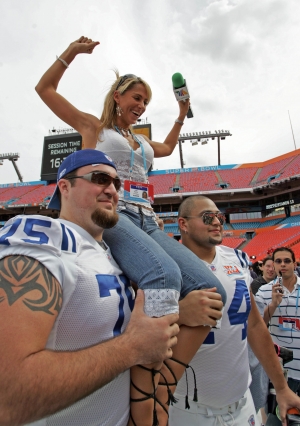 Locker rooms are not places for equal opportunity. They’re stinky, testosterone-packed places where dudes act like dudes, often with their junk hanging out. If male reporters aren’t allowed in female locker rooms, then female reporters shouldn’t be allowed in male locker rooms either.
Locker rooms are not places for equal opportunity. They’re stinky, testosterone-packed places where dudes act like dudes, often with their junk hanging out. If male reporters aren’t allowed in female locker rooms, then female reporters shouldn’t be allowed in male locker rooms either.
So the whole locker room stuff aside, was there a deeper, cultural dynamic at play? Are people in Mexico and Latin America just more comfortable with female sexuality than us squares here in the States?
“Probably in Latin America we are a little more used to that, that a man can say something nice to us, but not as a sexual thing. So like, ‘oh you’re pretty,’ or something like that. I don’t think that women can be sad about that. I don’t know, I think here in the States, everything is a little more formal, a little more… I don’t know, more different. It’s just different. But not exactly as you say in a sexual way,” Sainz told me.
“I’m proud to be a woman. I’m proud to be an attractive woman. I think that all the women in the world want to be as attractive as they can be.”
Sainz went on to explain that she works on television, and with broadcast journalism, whether it’s in Latin America or here in the States, trying to be attractive is part of the game.
And she’s right. Women want to be attractive, and attractive women shouldn’t have to hide their attractiveness in order to do their jobs. Even in the male-dominated world of sports journalism.
Sainz also had some sound advice for women who are considering careers in sports journalism.
“I would say that the most important thing that you can have is credibility,” Sainz said. “If you want to be a sports reporter, you need to love the sport. You need to feel a passion for sports, because if not, the people are not going to believe in you.”
Looks help, sure, but all that beauty stuff is secondary.
“In a way, if they can be a good looking girl, bravo. That’s a plus for you. But it’s only a plus, a compliment, not the first or main important thing,” she said.
With this whole Jets thing, Sainz wasn’t a victim, but she wasn’t a perpetrator either. She didn’t wield her sex appeal like a weapon, but she didn’t hide it. Why should she?
Sainz wasn’t taken advantage of that day at Jets practice, but she did take advantage of the situation. Why shouldn’t she? She’s got the credibility and the bonus-points looks. She didn’t create the controversy, but she didn’t back away from it either.
When publicity opportunities present themselves, people are going to take advantage of them. The Association for Women in Sports Media used the opportunity to promote gender equality and respect. Sainz took the opportunity to further her career. The NFL took the opportunity to educate players on sexual harassment of journalists.
The Jets players recently went through sensitivity training that I’m sure prompted more eye-rolling than any real changes of heart. Sainz agreed with me on that point.
“I think it’s going to do something good for the education, but as you say, it’s not like within two weeks they’re all going to be educated. I think that it’s very cultural. They probably need to see that it’s a good idea not to have this kind of interview [in the locker room]. And also, I know that most of the players are very well educated and don’t have any problems so … I don’t know. I just know that the NFL decided after my episode with the Jets that they need to make a special educational training for all the teams in the NFL. So okay, if the NFL says so, okay, I agree with that,” she said.
We all know that it won’t do a damn thing. Men act like fools in the locker room and they act like fools around gorgeous women. It’s just what we do. There’s no place for sexual harassment anywhere, but if the NFL wants to take steps to prevent harassment, they should listen to Sainz and create opportunities for female reporters to interact with players after they’ve had a chance to put their pants on.
Related Posts
| Print article | This entry was posted by Chris Stout on December 22, 2010 at 10:50 am, and is filed under Girls, Sports. Follow any responses to this post through RSS 2.0. Both comments and pings are currently closed. |
Comments are closed.







